Konstantin Danil | |
|---|---|
| Константин Данил | |
.jpg.webp) | |
| Born | 1798 |
| Died | 25 May 1873 (aged 75 or 77) |
| Known for | Painting |
| Notable work | Portrait of the wife Sofia Dely |
| Movement | Classicism, Biedermeier |
Konstantin Danil (Serbian Cyrillic: Константин Данил, Romanian: Constantin Dănilă, 1798-1873) was a Serbian painter of the 19th century. He is most famous for his portraits and religious painting.[1] Danil is considered to be the most important Serbian painter of Biedermeier.[1][2]
Biography
According to Felix Kanitz he was born to a Serbian family as Danilo Petrović.[3] Other sources state that his origin and birthplace is unclear.[4] He was born either in Lugoj or Ečka.[5] At the age of thirteen he left Lugoj for Timișoara, where he executed a drawing which procured his admission to the school of Arsenije Teodorović.[6] Teodorović was a principal of a drawing school, and through it he influenced a whole new generation of younger artists, including a few that rivaled him. One of them was Konstantin Danil. Here Konstantin Danil studied for several years, and produced, among other works, a figure of Saint Sava which attracted much attention. The Serbian master gave every encouragement to the young Konstantin Danil for the next four years. Artists had then already started to call Konstantin Danil Grigorović,[7] who was perpetually sketching all sorts of objects in art and in nature, by his father's name Danil. Konstantin Danil, who had by this time acquired so much mastery over the painting technique that his performances were barely distinguishable from Teodorović's own.
At the age of seventeen, he left Teodorović and went to the atelier of one of three Viennese academicians, then working in Temișvar. Danil also took lessons from itinerant portrait-painters and afterward entered as a student in the Academy of Arts in Vienna and in Munich. It was in Vienna and Munich, where he became influenced for a while by the works of classicist German painters Asmus Jacob Carstens, Joachim Christian Reinhart, Peter Fendi, Joseph Anton Koch, Gottlieb Schick and Bonaventura Genelli. He also took time to travel and paint throughout Banat and Erdelj (Transylvania). Danil had tried his skill in every genre, including portraiture, landscape, flower-painting, scenes of modern life and figure subjects. From Munich, Danil returned to Nagybecskerek (modern-day Zrenjanin), where he resumed the style of Teodorović, and shortly afterward Veliki Bečkerek became his permanent residence.[4]
He married German noblewoman Sofia Dely in 1827.[8] Danil painted local nobleman Karacsony, and when Karacsony became a Viceroy of Banat,[9] Danil's popularity grew.
Having spent much time in the military frontier, and having been with the Austrian troops in actual warfare, he made a specialty of rendering the Military Frontier officers and border men. At the same time, he produced a series of designs illustrative of Old Testament history.
From 1834 to 1873 Danil threw himself into the Biedermeier and the sacral painting based on the school of Vienna[10] Nazarene movement, and became one of its regional leaders. He worked in his own atelier at 37 Tsar Dušan Street[4] in Veliki Bečkerek where numerous Serbian artists were apprenticed,[11] including poet-painter Đura Jakšić[11] and artist Lazar Nikolić, who wrote a biography of his teacher.[12]
Danil was a Serbian Orthodox Christian.[4] In 1872 his wife, Sofia Dely, died, and a year later (1873), Danil died in Nagybecskerek on 13 May.[8]
Work
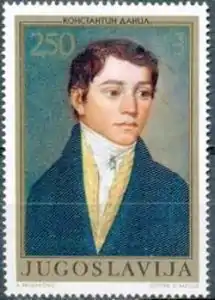
His chief pictures are Madonna, Male Portrait, Still Life, Stanci Dely (his father-in-law), Archangel Gabriel, Ms Vaigling, Ms Tetesi, and, best known of all, General Stevan Kničanin and Portrait of Maria (1872). The portraits of his wife Sofia Dely (1840), Petar Jagodić, and A Lady with a Cross are among his best achievements in this class.[13] Danil painted a number of portraits of the wealthe Jagodić family.[14]
Portrait of Captain Kljunović and his wife impressed a Serbian Orthodox priest by the name of Arsenović, who selected Danil to decorate the walls, dome and iconostasis of a new Serbian Orthodox church in Pančevo with figures of saints. Upon completion of his commission (iconostasis) in 1833 Danil received an honorarium of 4,000 silver florins.[14] Iconostases painted by Danil can also be found in Timișoara, Uzdin, Dobrica and Jarkovac.[15][16][17]
Public collections
His work can be found in the following public collections:
- National Museum of Serbia
- Gallery of Matica Srpska
- Timișoara Art Museum
- National Museum of Pančevo[9]
- National Museum of Zrenjanin[9]
- A lot of his work used to be found in private collections.[7]
Legacy
Danil is remembered as a master of technique, and his portraits reveal an extraordinary study into the characters of his subjects.[16] Nevertheless, for some time after his death his name was almost forgotten by the public, and it is only in the twentieth century that he has been conceded the position among the masters of the modern Serbian school which is his due.
On the basis of his early art work in Temișvar, Konstantin Danil is also claimed by three other nations, Romania, Austria and Hungary.[18]
He is included in The 100 most prominent Serbs.
Gallery
 Portrait of Pavle Kenđelac, 1832-1834
Portrait of Pavle Kenđelac, 1832-1834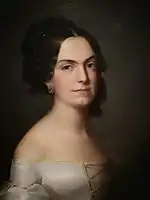 Portrait of Madame Tőtössy,1835-1840
Portrait of Madame Tőtössy,1835-1840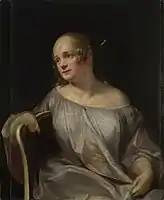 Portrait of the wife Sofia Dely
Portrait of the wife Sofia Dely Portrait of mrs. Vailgling
Portrait of mrs. Vailgling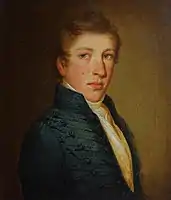 Danil Jagodić, 1873
Danil Jagodić, 1873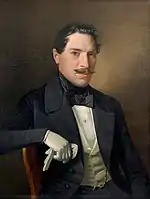 Man in White Gloves, 1873
Man in White Gloves, 1873
See also
References
- 1 2 "Бидермајер". www.galerijamaticesrpske.rs. Archived from the original on 2017-09-29. Retrieved 2020-01-29.
- ↑ Поповић, Александра; Арђелан, Золтан (2019). Војвођански мозаик, цртице из културе националних заједница Војводине (PDF). Нови Сад: Покрајински секретаријат за образовање, прописе , управу и националне мањине – националне заједнице.
- ↑ Kanitz, Felix Philipp (2007). Srbija : zemlja i stanovništvo od rimskog doba do kraja XIX veka (1. izd ed.). Beograd: Logos art. ISBN 978-86-7360-062-8.
- 1 2 3 4 Ђукић, Ђуро. "У потрази за гробом сликара". Politika Online. Retrieved 2020-01-29.
- ↑ "Pancevac Online". www.pancevac-online.rs. Retrieved 2020-01-29.
- ↑ "Arte - Konstantin Danil - Biografija". www.arte.rs. Retrieved 2020-01-29.
- 1 2 Znameniti srbi XIX. veka ; (1800-1900) ; Urednik Andra Gavrilović: .... Godina (. Srpska Štamp. 1901.
- 1 2 "СОФИЈА, МОЈ АНЂЕО!". Политикин забавник. Retrieved 2020-01-29.
- 1 2 3 Даниловић, Ј. "Велики мајстор кичице". Politika Online. Retrieved 2020-01-29.
- ↑ Mitchell, Laurence (2017-09-05). Serbia. Bradt Travel Guides. ISBN 978-1-78477-056-3.
- 1 2 "Arte - Konstantin Danil - Vesti". www.arte.rs. Retrieved 2020-01-29.
- ↑ Nikolić, Lazar; Nikolić, Vladimir (1895). Srpski slikari: prilog kulturnoj povestnici srpskog naroda (in Serbian). Štamparija Jove Karamat.
- ↑ "Konstantin Danil". www.artnit.net. Retrieved 2020-01-29.
- 1 2 admin (2017-12-08). "ДО ТАДА ЈЕ СЛИКАО ПОРТРЕТЕ УВАЖЕНИХ ГОСПОЈА". Start013 (in Serbian). Retrieved 2020-01-29.
- ↑ "Srpska Pravoslavna Crkva u Rumuniji - Temisvar / Saborna crkva". www.rastko.rs. Retrieved 2020-01-29.
- 1 2 Blic. "Otvaranje Narodnog muzeja na "Blic" UČITELJ ĐURE JAKŠIĆA". Blic.rs (in Serbian). Retrieved 2020-01-29.
- ↑ Baedeker, Karl. Dalmatia & the Adriatic. Lulu.com. ISBN 978-0-244-97076-5.
- ↑ "Umro je slikar Konstantin Danil". MK Fondacija Srpski Legat. May 25, 2018.
Further reading
- Euphrosine, Nemzeti Újság, 1840
- Pesti Hirlap, Temesvarer Wochenblatt (1841), 45, 1845. 49);
- Lazar Nikolić, Srpski slikari, 1895
- Dr. István Berkeszi, Temišvarski slikari, 1909
- Sendrej-Sentivany, Leksikon ugarskih likovnih umjetnika, 1915
- Petrović, Veljko (1927). "Konstantin Danil". Narodna enciklopedija. Zagreb: Bibliografski zavod.
- Adrian Negru, Constantin Daniel, Libertatea, Panciova;, 1996
- Adrijan Negru, Slikarske radionice u Banatu u XVIII i XIX veku, Viša škola za obrazovanje vaspitača, Vršac, 2003
External links
- Terminartors.com
- Portrait of Maria at the Wayback Machine (archived February 13, 2006)
- Portrait of Petar Jagodic